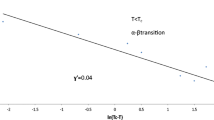Summary
Cooke, Meyer, Wolf, Evans andRichards (Proc. Roy. Soc.,225, 112 (1954)) have measured at low temperatures the susceptibility of oxygen dissolved in aβ-quinol compound, wherein the oxygen molecules are 8 Å apart, and the deviation of the susceptibility from that in the gaseous state may hence be small. They find that16O18O and16O16O have the same susceptibility, although at low temperatures the magnetic behavior in the gaseous state should be different, inasmuch as only odd values ofK are allowed for16O16O. The present paper shows that the magnetic behavior can be explained on the assumption that at helium temperatures the O2 molecules do not rotate freely, but instead are aligned along a particular spatial direction. Calculations by MissO’Brien show that the susceptibility curves can be fitted by assuming the axis of the O2 molecule is «frozen» in space and that the spin-spin parameter is about 25 percent lower than in the gas. This apparent reduction can be explained on the basis that the molecule is not rigidly frozen, and instead has a potential barrier of about 50 cm−1.
Similar content being viewed by others
Author information
Authors and Affiliations
Rights and permissions
About this article
Cite this article
Van Vleck, J.H. The magnetic susceptibility of oxygen in a clathrate compound. Nuovo Cim 6 (Suppl 3), 1236 (1957). https://doi.org/10.1007/BF02834731
Published:
Issue Date:
DOI: https://doi.org/10.1007/BF02834731



